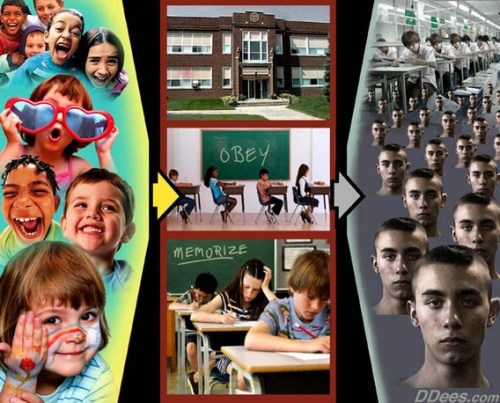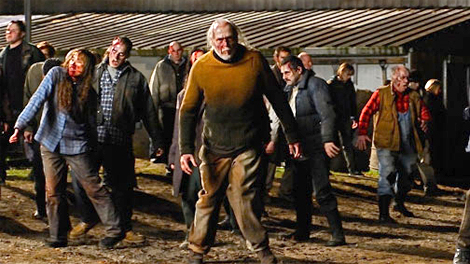huffingtonpost.com | Feb 2, 2013
by John W. Whitehead
Just as the 9/11 terrorist attacks created a watershed between the freedoms we enjoyed and our awareness of America’s vulnerability to attack, so the spate of school shootings over the past 10-plus years from Columbine to Newtown has drastically altered the way young people are perceived and treated, transforming them from innocent bystanders into both victims and culprits. Consequently, school officials, attempting to both protect and control young people, have adopted draconian zero-tolerance policies, stringent security measures and cutting-edge technologies that have all but transformed the schools into quasi-prisons.
In their zeal to make the schools safer, school officials have succumbed to a near-manic paranoia about anything even remotely connected to guns and violence, such that a child who brings a piece of paper loosely shaped like a gun to school is treated as harshly as the youngster who brings an actual gun. Yet by majoring in minors, as it were, treating all students as suspects and harshly punishing kids for innocent mistakes, the schools are setting themselves and us up for failure — not only by focusing on the wrong individuals and allowing true threats to go undetected but also by treating young people as if they have no rights, thereby laying the groundwork for future generations that are altogether ignorant of their rights as citizens and unprepared to defend them.
Nowhere is this more evident than in the increasingly harsh punishments and investigative tactics being doled out on young people for engaging in childish behavior or for daring to challenge the authority of school officials. Whereas in the past minor behavioral infractions at school such as shooting spitwads may have warranted a trip to the principal’s office, in-school detention or a phone call to one’s parents; today, they are elevated to the level of criminal behavior with all that implies. Consequently, young people are now being forcibly removed by police officers from the classroom, strip searched, arrested, handcuffed, transported in the back of police squad cars, and placed in police holding cells until their frantic parents can get them out. For those unlucky enough to be targeted for such punishment, the experience will stay with them long after they are allowed back at school. In fact, it will stay with them for the rest of their lives in the form of a criminal record.
Consider the case of Wilson Reyes, a seven-year-old elementary school student from the Bronx who got into a scuffle with a classmate over a $5 bill. In response to the incident, school officials called police, who arrested Reyes, transported him to the police station and allegedly handcuffed the child to a wall and interrogated him for ten hours about his behavior and the location of the money. His family is in the midst of pursuing a lawsuit against the police and the city for their egregious behavior.
A North Carolina public school allegedly strip-searched a 10-year-old boy in search of a $20 bill lost by another student, despite the fact that the boy, J.C., twice told school officials he did not have the missing money. The assistant principal, a woman, reportedly ordered the fifth grader to disrobe down to his underwear and subjected him to an aggressive strip-search that included rimming the edge of his underwear. The missing money was later found in the school cafeteria.
And in Chicago, a 15-year-old boy accused by an anonymous tipster of holding drugs was taken to a locker room by two security guards, a Chicago police officer, and a female assistant principal, and made to stand against a wall and drop his pants while one of the security guards inspected his genitals. No drugs were found.
That students as young as seven years old are being strip searched by school officials, over missing money no less, flies in the face of the U.S. Supreme Court’s 2009 ruling in Safford Unified. Sch. Dist. v. Redding. Insisting that Arizona school officials violated the Fourth Amendment rights of a 13-year-old girl when they strip-searched her on the suspicion she was hiding ibuprofen in her underwear, the justices declared that educators cannot force children to remove their clothing unless student safety is at risk.
Precedent-setting or not, however, the Court’s ruling has done little to improve conditions for young people who are the unfortunate casualties in the schools’ so-called quest for “student safety.” Indeed, with each school shooting, the climate of intolerance for “unacceptable” behavior such as getting into food fights, playing tag, doodling, hugging, kicking, and throwing temper tantrums only intensifies. And as surveillance cameras, metal detectors, police patrols, zero tolerance policies, lock downs, drug sniffing dogs and strip searches become the norm in elementary, middle and high schools across the nation, the punishments being meted out for childish behavior grow harsher.
Even the most innocuous “infractions” are being shown no leniency, with school officials expelling a 6-year-old girl for bringing a clear plastic toy gun to school, issuing a disciplinary warning to a 5-year-old boy who brought a toy gun built out of LEGOs to class, and pulling out of school a fifth-grade girl who had a “paper” gun with her in class. The six-year-old kindergarten student in South Carolina was classified as such a threat that she’s not even allowed on school grounds. “She cannot even be in my vehicle when I go to pick up my other children,” said the girl’s mom, Angela McKinney.
Nine-year-old Patrick Timoney was sent to the principal’s office and threatened with suspension after school officials discovered that one of his LEGOs was holding a 2-inch toy gun. That particular LEGO, a policeman, was Patrick’s favorite because his father is a retired police officer. David Morales, an 8-year-old Rhode Island student, ran afoul of his school’s zero tolerance policies after he wore a hat to school decorated with an American flag and tiny plastic Army figures in honor of American troops. School officials declared the hat out of bounds because the toy soldiers were carrying miniature guns. A 7-year-old New Jersey boy, described by school officials as “a nice kid” and “a good student,” was reported to the police and charged with possessing an imitation firearm after he brought a toy Nerf-style gun to school. The gun shoots soft ping pong-type balls.
School officials are also exhibiting zero tolerance for the age-old game of cops and robbers, a playground game I played as a child. In a new wrinkle on this old game, however, it’s not the cop who gets the bad guy. Now, the game ends when school officials summon real cops who arrest the kindergartners for engaging in juvenile crime. That happened at a New Jersey school, from which four little boys were suspended for pretending their fingers were guns. Most recently, two children at two different schools in Maryland were suspended in the same month for separate incidents of pretending their fingers were guns. In another instance, officials at a California elementary school called police when a little boy was caught playing cops and robbers at recess. The principal told the child’s parents their child was a terrorist.
Unwittingly, the principal was right on target: These are acts of terrorism, however, the culprits are not overactive schoolchildren. Rather, those guilty of terrorizing young children and parents nationwide are school officials who — in an effort to enforce zero tolerance policies against violence, weapons and drugs — have moved our schools into a lockdown mentality.
Things have gotten so bad that it doesn’t even take a toy gun, pretend or otherwise, to raise the ire of school officials. A high school sophomore was suspended for violating the school’s no-cell-phone policy after he took a call from his father, a master sergeant in the U.S. Army who was serving in Iraq at the time. A 12-year-old New York student was hauled out of school in handcuffs for doodling on her desk with an erasable marker. In Houston, an 8th grader was suspended for wearing rosary beads to school in memory of her grandmother (the school has a zero tolerance policy against the rosary, which the school insists can be interpreted as a sign of gang involvement). And in Oklahoma, school officials suspended a first grader simply for using his hand to simulate a gun.
With the distinctions between student offenses erased, and all offenses expellable, we now find ourselves in the midst of what TIME magazine described as a “national crackdown on Alka-Seltzer.” Indeed, at least 20 children in four states have been suspended from school for possession of the fizzy tablets in violation of zero tolerance drug policies. In some jurisdictions, carrying cough drops, wearing black lipstick or dying your hair blue are actually expellable offenses.
Students have also been penalized for such inane “crimes” as bringing nail clippers to school, using Listerine or Scope, and carrying fold-out combs that resemble switchblades. A 9-year-old boy in Manassas, Va., who gave a Certs breath mint to a classmate, was actually suspended, while a 12-year-old boy who said he brought powdered sugar to school for a science project was charged with a felony for possessing a look-alike drug. Another 12-year-old was handcuffed and jailed after he stomped in a puddle, splashing classmates. After students at a Texas school were assigned to write a “scary” Halloween story, one 13-year-old chose to write about shooting up a school. Although he received a passing grade on the story, school officials reported him to the police, resulting in his spending six days in jail before it was determined that no crime had been committed.
These incidents, while appalling, are the byproducts of an age that values security over freedom, where police have relatively limitless powers to search individuals and homes by virtue of their badge, and where the Constitution is increasingly treated as a historic relic rather than a bulwark against government abuses. Where we go from here is anyone’s guess, but the future doesn’t look good from where I’m sitting — not for freedom as we know it, and certainly not for the young people being raised on a diet of abject compliance to police authority, intolerance for minor offenses, overt surveillance and outright totalitarianism.











